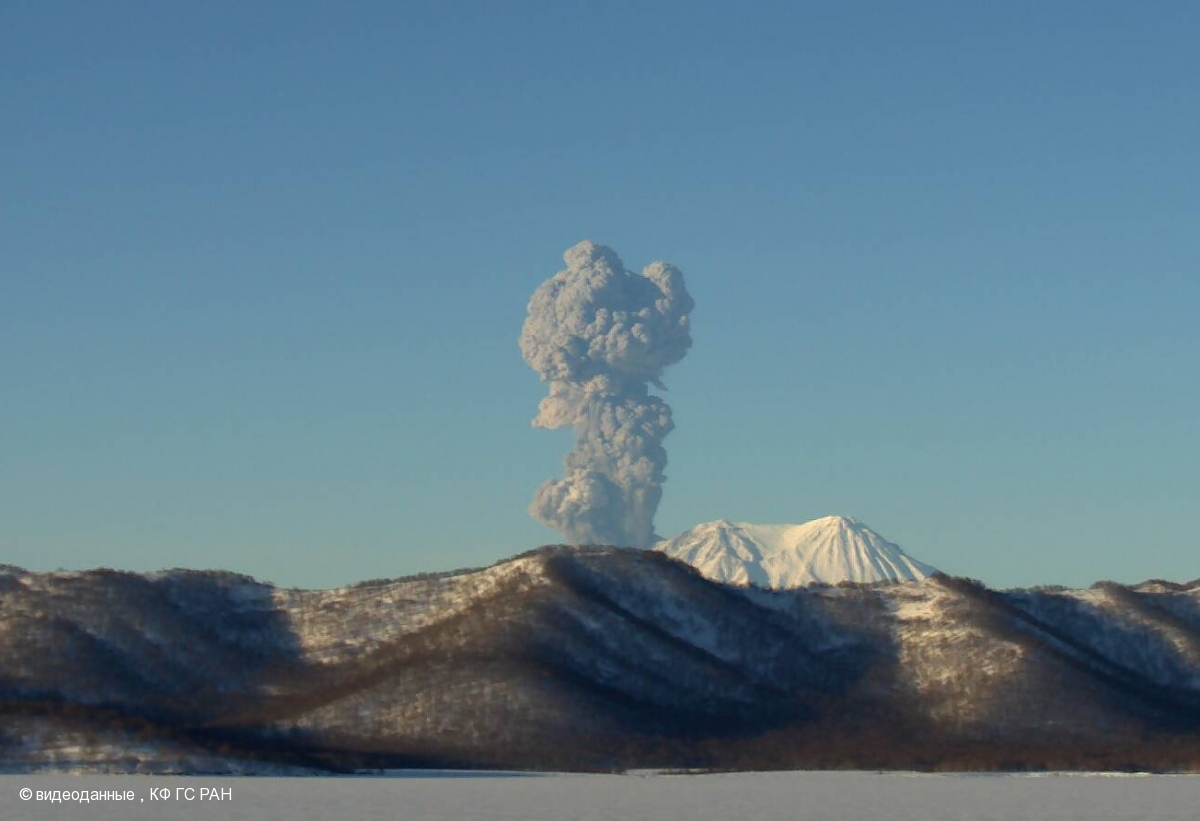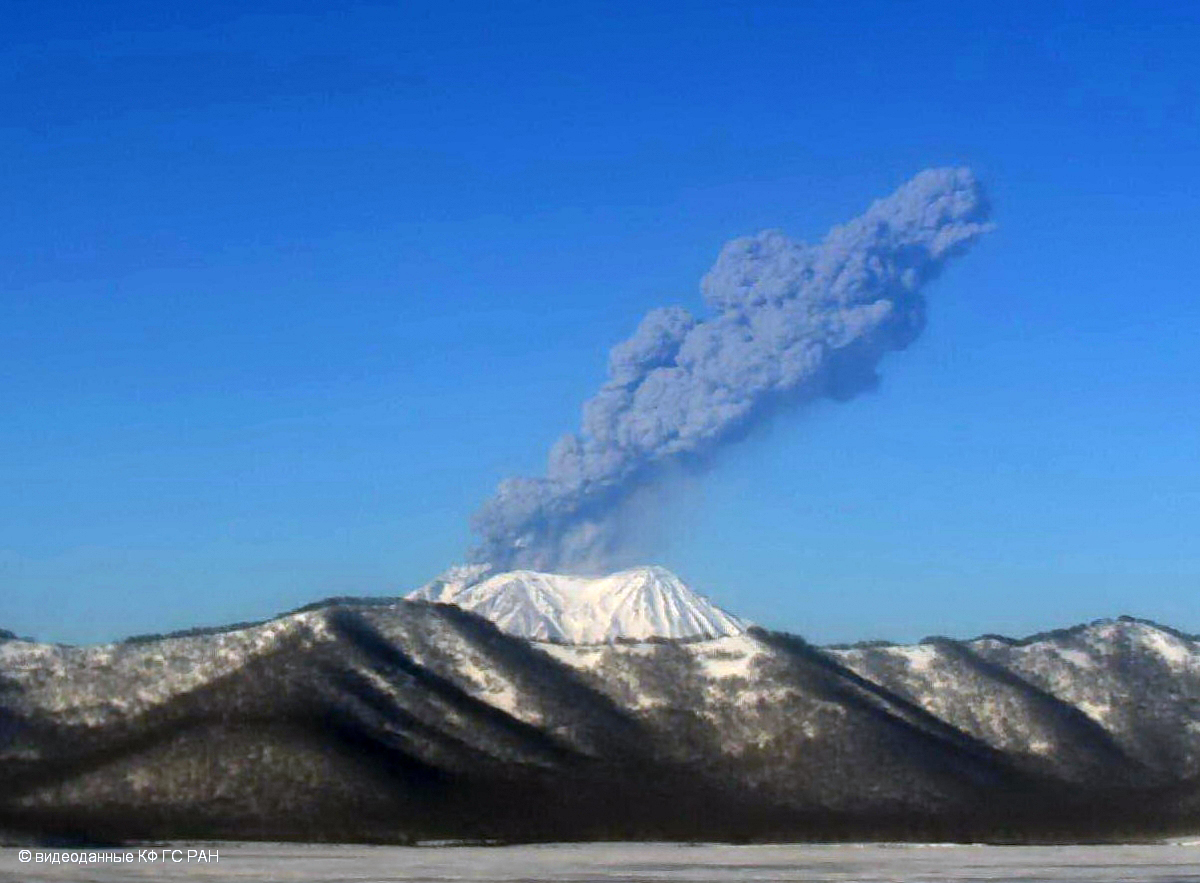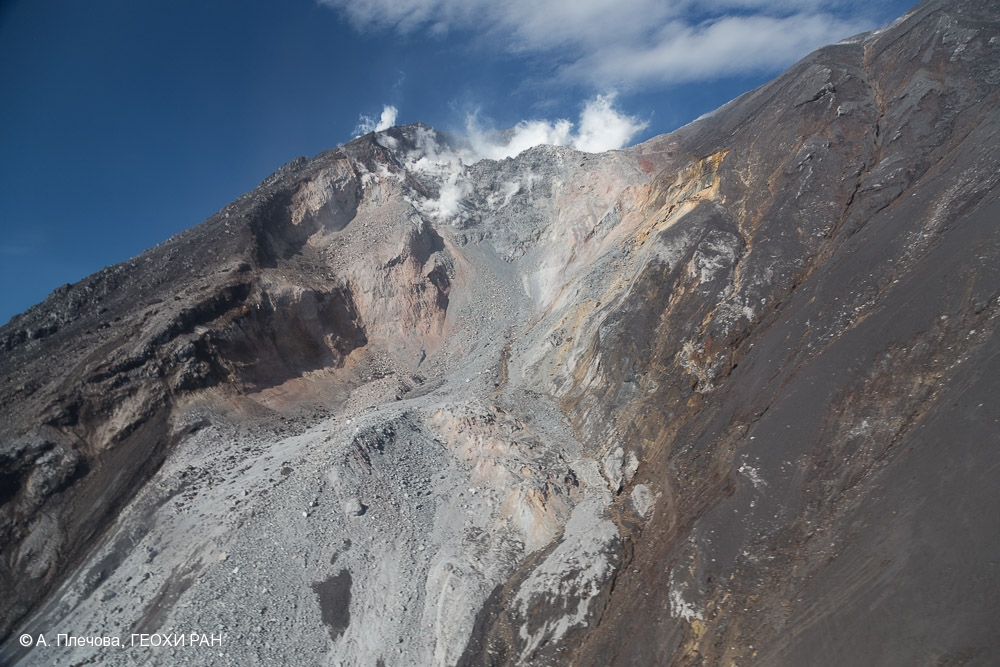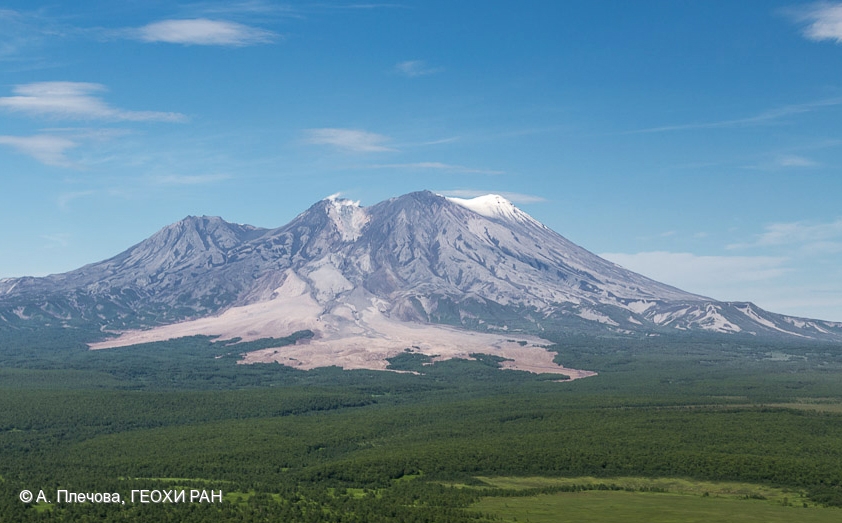Report on Zhupanovsky (Russia) — April 2017
Bulletin of the Global Volcanism Network, vol. 42, no. 4 (April 2017)
Managing Editor: Edward Venzke.
Research and preparation by Paul Berger.
Zhupanovsky (Russia) Moderate ash plumes continued until 24 March, then an explosion on 20 November 2016
Please cite this report as:
Global Volcanism Program, 2017. Report on Zhupanovsky (Russia) (Venzke, E., ed.). Bulletin of the Global Volcanism Network, 42:4. Smithsonian Institution. https://doi.org/10.5479/si.GVP.BGVN201704-300120
Zhupanovsky
Russia
53.589°N, 159.15°E; summit elev. 2899 m
All times are local (unless otherwise noted)
A brief eruption that began on 23 October 2013 was the first reported activity at Zhupanovsky since 1959 (BGVN 39:09). After another eight months of quiet, eruptive activity began again in early June 2014 that was characterized by periods of frequent, moderate, ash-generating explosions that continued through the end of that year (BGVN 39:09). As described below, similar activity continued from January 2015 through 24 March 2016, with periods of strong explosions generating ash plumes as high as 10 km altitude. Another long period of eight months without observed activity was broken by a large eruption on 20 November 2016. No additional activity was reported through March 2017. Most of the data comes from Kamchatka Volcanic Eruption Response Team (KVERT) reports. Often, the volcano is obscured by clouds. All reported dates are UTC unless otherwise noted (local = -12 hours).
Activity during 2015. According to KVERT, the moderate eruption with explosions generating ash plumes continued into 2015 (table 3). The Aviation Color Code remained Orange (third level on a four-color scale) between 1 January and 15 May 2015. After an explosion on 3 April, explosive activity waned and KVERT lowered the Aviation Color Code from Orange to Yellow (second level on a four-color scale) on 16 May. On 9 June 2015, activity increased again, with webcam and satellite images showing an ash plume rising to an altitude of 6 km. The Aviation Color Code was raised on 8 June to Orange. During an overflight on 16 July, volcanologists observed fresh deposits at the foot of the volcano from collapses of the S section of the active Priemysh Crater that likely occurred on 12 July (figures 7 and 8). Moderate activity at the crater continued through 17 July; the Aviation Color Code was lowered to Yellow on 18 June and to Green on 23 July. On 7 August KVERT reported that explosive activity had ended, but collapses of the S part of the active crater continued. On 6 August ash plumes rose to an altitude of 5 km and drifted 25-60 km SW, triggering KVERT to raise the Aviation Color Code to Yellow. The code was lowered back to Green on 13 August.
Table 3. Summary of reported activity at Zhupanosky, January 2015-March 2016. Data is from webcam images, satellite images, and visual observations. On many days, clouds obscured visibility. Courtesy of KVERT and Tokyo VAAC.
| Date (UTC) | Ash Plume altitude (km) | Plume drift | Thermal anomaly | Other |
| 2015 Jan 6 | -- | 50 km E | -- | -- |
| 2015 Jan 11-12 | 5 | 40 km SW | 12 Jan | -- |
| 2015 Jan 17-21 | -- | 300 km SW, E | 17-20 Jan | -- |
| 2015 Jan 22, 25-26 | 5-6 | 160 km SW, SE | 23, 25-27 Jan | -- |
| 2015 Jan 30-6 Feb | -- | -- | Daily | -- |
| 2015 Feb 6, 9 | 3 | 65 km W | Daily | -- |
| 2015 Feb 15-19 | 3-3.5 | 200 km W, SE | 14-15,18 Feb | -- |
| 2015 Feb 20-27 | 3-3.5 | 250 km E, SE | 20-22, 25-26 Feb | -- |
| 2015 Feb 27-6 Mar | 3-8 | 400 km E | 27 Feb, 1 Mar | -- |
| 2015 Mar 7-8 | 6-7 | 333 km E (7, 10 Mar), 232 km NE (8 Mar) | 7-10 Mar | -- |
| 2015 Mar 12, 15 | 7 | 350 km NE, S | 14-17 Mar | Incandescence on 15 Mar |
| 2015 Mar 25 | 8 | 100 km ENE | Daily | -- |
| 2015 Mar 27-2 Apr | -- | -- | 26, 30 Mar, 2 Apr | -- |
| 2015 Apr 3 | -- | 25 km SE | -- | -- |
| 2015 Apr 9 | -- | -- | 9 Apr | -- |
| 2015 Apr 10-17 | -- | -- | 16-17 Apr | -- |
| 2015 Apr 23-1 May | -- | -- | 23, 25, 28 Apr | -- |
| 2015 May 1-8 | -- | -- | 3, 5 May | -- |
| 2015 May 8-15 | -- | -- | 14 May | -- |
| 2015 May 20-23 | -- | 470 km E | 23 May | -- |
| 2015 Jun 7-9 | 6 | 95 km S, 250 km SE | 8-9 June | -- |
| 2015 Jun 12-19 | -- | 150 km W | 16 June | -- |
| 2015 Jul 3-10 | -- | SW on 6 July | -- | -- |
| 2015 Jul 12 | 10 | 1,100 km SE | -- | Ashfall at Petropavlovsk-Kamchatsky (12 Jul) |
| 2015 Jul 14 | 2 | 60 km S | -- | -- |
| 2015 Aug 6 | 5 | 25-60 km SW | -- | -- |
| 2015 Nov 27 | 6-7 | 300 km E, SE | Over volcano | -- |
| 2015 Nov 30 | 9 | 300 km E, SE | Over both volcano and pyroclastic flow | Pyroclastic flow deposits 15.5 km long observed on S flank |
| 2015 Dec 3-4 | -- | -- | Over pyroclastic flow | -- |
| 2015 Dec 5-7 | -- | -- | 7 Dec | -- |
| 2016 Jan 19-21 | 7-8 | 80 km NE, 36 km W | 19, 21 Jan | Plume 150 km long observed 50 km NE |
| 2016 Jan 24 | 8 | 235 km NNE | 23 Jan | -- |
| 2016 Jan 29-5 Feb | -- | -- | 30 Jan | -- |
| 2016 Feb 5, 7, 9, 11 | 7 | 546 km E, N | 5,9-11 Feb | -- |
| 2016 Feb 12-13 | 7; 10; 1 | 2 km E; 50-200 km SE, E; 600 km E, NE; 288 km ESE | 12-13 Feb | Aviation Color Code raised to Red. |
| 2016 Mar 24 | 8 | 8 x 10 km ash cloud 134 km NW at 3.5-4 km altitude | -- | -- |
KVERT indicated that activity remained low until 27 November 2015 when, based on satellite images, ash plumes rose to altitudes of 5-6 km and drifted 285 km E. The Aviation Color Code was raised to Orange. IVS FED RAS (Institute Volcanology and Seismology Far East Division of the Russian Academy of Sciences) observers noted an ash explosion at 0356 on 30 November (UTC); the Tokyo Volcanic Ash Advisory Center (VAAC) reported that the resulting ash plume rose to an altitude of 9 km. Pyroclastic flow deposits 15.5 km long were observed on the S flank after the 30 November event.
According to KVERT, activity decreased after a partial collapse of the S central sector on 27 and 30 November 2015. Satellite images detected a very weak thermal anomaly over the volcano on 4 and 7 December. Moderate levels of fumarolic activity continued. On 10 December the Aviation Color Code was lowered to Yellow. By early-to-mid December 2015, only moderate levels of fumarolic activity were observed. On 17 December the Aviation Color Code was lowered to Green.
KVERT reported that thermal anomalies occurred frequently during the reporting period; often they were obscured by clouds. The only MODVOLC thermal alerts, based on MODIS anomalies, during the reporting period were during March-June 2015: on 7 March, 8 March (2 pixels), 15 March (2 pixels), 21 March (2 pixels), 20 May, and 16 June.
Activity during 2016. The eruption pattern of fluctuating activity levels continued into 2016. Based on visual observations, KVERT reported that at 1636 on 19 January 2016 (UTC), an explosion generated an ash plume that rose to an altitude of 7-8 km and drifted 20 km E (figure 9). The Aviation Color Code was raised to Orange.
 |
Figure 9. Photo of the ash column rising from Zhupanovsky, 19 January 2016. Still image taken from webcam video. Courtesy of Institute of Volcanology and Seismology FEB RAS, KVERT. |
Moderate steam-and-gas activity continued during 5 February-18 March. An explosion at 2029 on 12 February (UTC) was recorded by a video camera and generated an ash plume that rose to an altitude of 7 km and drifted E. A larger explosion visually observed a minute later generated an ash plume that rose to an altitude of 10 km and drifted 50 km SE. The Aviation Color Code was raised to Red for several hours. In a report issued at 2334 (UTC), KVERT noted that only moderate amounts of gas and steam rose from the volcano; the Aviation Color Code was lowered to Orange. Ash from the earlier explosions drifted E over Kronotsky Bay and NW. A few hours later, an ash plume was detected in satellite images rising 1 km above the volcano and drifting 288 km E.
The Tokyo VAAC recorded an explosion at 1320 on 24 March (UTC) that generated an ash plume which rose to an altitude of 8 km. After the explosion, no further activity was observed. A very weak thermal anomaly was detected over the volcano in satellite images on 1 and 10 April. The Aviation Color Code was thus lowered to Yellow on 13 April. The last thermal anomaly detection in a satellite image was on 10 April. However, moderate fumarolic activity continued. The Aviation Color Code was lowered to Green on 16 June.
At 1429 on 20 November 2016 a webcam recorded ash plumes rising to altitudes of 6-8 km and drifting 73 km E (figure 10); the Aviation Color Code was raised from Green to Orange. No further activity was observed, and on 22 November the Aviation Color Code was lowered to Yellow.
 |
Figure 10. Photo of the ash column rising from Zhupanovsky and extending E, 20 November 2016. Still image taken from webcam video. Courtesy of Institute of Volcanology and Seismology FEB RAS, KVERT. |
Geological Summary. The Zhupanovsky volcanic massif consists of four overlapping stratovolcanoes along a WNW-trending ridge. The elongated complex was constructed within a Pliocene-early Pleistocene caldera whose rim is exposed only on the eastern side. Three of the stratovolcanoes were built during the Pleistocene. An early Holocene stage of frequent moderate and weak eruptions from 7,000 to 5,000 years before present (BP) was followed by a period of infrequent larger eruptions that produced pyroclastic flows. The last major eruption took place about 800-900 BP. Recorded eruptions have consisted of relatively minor explosions from Priemysh, the third cone from the E about 2.5 km from the summit peak.
Information Contacts: Kamchatka Volcanic Eruptions Response Team (KVERT), Far East Division, Russian Academy of Sciences, 9 Piip Blvd., Petropavlovsk-Kamchatsky, 683006, Russia (URL: http://www.kscnet.ru/ivs/kvert/); Institute of Volcanology and Seismology, Far Eastern Branch, Russian Academy of Sciences, (IVS FEB RAS), 9 Piip Blvd., Petropavlovsk-Kamchatsky 683006, Russia (URL: http://www.kscnet.ru/ivs/eng/); Tokyo Volcanic Ash Advisory Center (VAAC), 1-3-4 Otemachi, Chiyoda-ku, Tokyo, Japan (URL: http://ds.data.jma.go.jp/svd/vaac/data/); Hawai'i Institute of Geophysics and Planetology (HIGP), MODVOLC Thermal Alerts System, School of Ocean and Earth Science and Technology (SOEST), Univ. of Hawai'i, 2525 Correa Road, Honolulu, HI 96822, USA (URL: http://modis.higp.hawaii.edu/).



